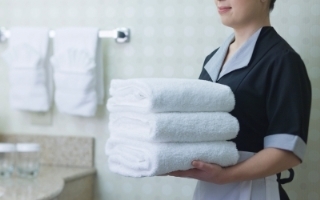2. Transporting soiled linens to the laundry
Keep the linens off the floors and away from the cart wheels. Soiled damp linens should be washed promptly and not allowed to sit in carts or chutes for long periods (mold and mildew could grow).
3. Sorting
Wear gloves when handling soiled linen. All linens should be opened up fully to look for stains and to shake out any loose items/soils wrapped up in the linen. Sort linens by load type and by degree of soiling.
4. Washer Loading
If you have a scale in the laundry (this is preferred), weigh out each load to within 90 to 100% of the reco load. Do not overfill a machine or the quality of wash will suffer. Underfilled loads waste money and time.
5. To replace an empty chemical bucket
Wear protective gloves and glasses. Unscrew the proportioning cap connected to tubing on the empty bucket and set cap somewhere it will remain clean. Move empty bucket away from position. Set the new bucket in place with the shipping cap secured. Loosen and remove the shipping cap with the cap wrench. Screw the proportioning cap (with the tube) to the bucket and tighten. Make sure the right proportioning cap is connected to the right bucket by matching colors. Screw the shipping cap from the new bucket onto the opening of the empty bucket. Dispose of the empty bucket in the dumpster.

CHLORINE BLEACHING POWDER VIC - CLOR II
6. Washing
Select the appropriate washing machine program for the type of load in the washer and also select the appropriate dispenser program number. Stagger the starting times of the washers at least 2 to 5 minutes.
7. Extracting
Linens should be only slightly damp after the wash cycle is completed. If there is water dripping from the linens, contact your machine supplier to check the extraction time.
8. Drying
Lint filters should be cleaned at least once per day or as specified by the manufacturer. Dry linens as soon as the washer is finished. Do not mix load types in the dryer. Do not overdry linens, use a cool down tumbling period to minimize wrinkles. Do not leave linens in the dryer overnight.
9. Finishing/ironing
Only feed linens at the proper moisture level through flatwork ironers. Keep the ironer clean and do not iron dirty linens.

OXYGEN BLEACHING POWDER DENWELL (VIC-OXY)
10. Folding
Linens should be folded immediately after drying or ironing to minimize wrinkles. The person doing the folding should look for stains, excessive wear or tears and sort out these linens for additional treatment. Do not send an unacceptable piece of linen to a room hoping the guest will not notice it.
11. Storing
Let the linens rest for a day before using. This will increase linen life and decrease wrinkles.
12. Transferring linens to use area.
Keep the clean and folded linens off the floor. Do not jam a stack of linens into the room attendant carts or onto shelves (may tear or wrinkle them).
13. Miscellaneous
Inventory – try to keep 2 to 3 par of linens on hand. Having to strip rooms to collect soiled linens to begin washing is a waste of labor and prevents the linens from resting. Take inventory every couple months and replace linens as needed to maintain par.

FABRIC SOFTENER DENWELL (VIC-SOFT)
Use spring loaded cart inserts to keep the linens within reach of the workers. Keep the inserts and the carts cleaned regularly (especially the bottoms). If possible, have carts designated for dirty linens and separate carts for clean linen.
Keep an adequate supply of rags in the laundry and on the room attendant carts, so workers will not be tempted to use good linens where they may be ruined. Cleaning rags should always be sorted from guest linens and washed separately.
Keep the floor of the laundry swept to discourage ants from being attracted to pieces of food dropped from the linens during sorting.
Think about ways to minimize how many times a piece of linen is handled.